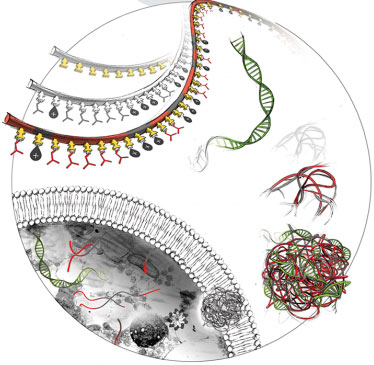| Jun 09, 2016 |
New polymers explore their application in gene therapy
|
|
(Nanowerk News) Speaking of materials is now talking about polymers. Many of the objects that surround us today would not exist, at least not as we know, without this type of macromolecules, which are the key players in numerous biological processes. For instance, the DNA instruction book of life is one of the most famous biopolymers.
|
|
The structure of polymeric materials is composed of repeating units that store information encoded on its chemical composition. This particular feature allows the application of polymers as models to mimic, or even influence, different biological processes.
|
|
With this in mind, a team of scientists led by the CiQUS researcher and ERC granted, Javier Montenegro, in collaboration with Dr. Fernandez-Trillo (University of Birmingham) has now described the modification of a polymer library for the activation of its membrane transport capabilities. This particular polymer is used to transport nucleotides across the cell membrane. The new protocol allows the in situ activation of the polymer through dynamic chemical reactions under physiological conditions (i.e. in the presence of water) and without any purification or isolation steps.
|
|
Using this methodology, the researchers have activated polymers for the transport of DNA through lipid bilayers. This protocol allowed a very quick and straightforward screening of different activated polymers, allowing the identification of new candidates for the delivery of small interfering RNA (siRNA).
|
 |
|
These results of the work featured on the cover picture of the journal Angewandte Chemie ("In Situ Functionalized Polymers for siRNA Delivery") hat highlights that this new synthetic protocol as a novel protocol with potential applications in 'gene therapy'. In this case by interfering with DNA transcription and knocking-down the synthesis of a selected protein. Furthermore, the developed polymers showed no toxicity in human HeLa cells, allowing the potential application of this technology in the field of massive screening of bioactive polymers in gene therapy as well as in other areas of biological interest, such as development of antimicrobial polymers.
|
|
Technical note
|
|
Researchers reported a new method for screening the biological activity of functional polymers across a consistent degree of polymerization and in situ, that is, under aqueous conditions and without purification/isolation of candidate polymers. The chemical functionality of a poly(acryloyl hydrazide) scaffold was activated under aqueous conditions using readily available aldehydes to obtain amphiphilic polymers. The transport activity of the resulting polymers can be evaluated in situ using model membranes and living cells without the need for tedious isolation and purification steps.
|
|
This technology allowed the rapid identification of a supramolecular polymeric vector with excellent efficiency and reproducibility for the delivery of siRNA into human cells (HeLa-EGFP). The reported method constitutes a blueprint for the high-throughput screening and future discovery of new polymeric functional materials with important biological applications.
|

